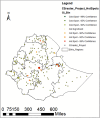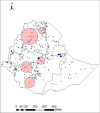Spatial distribution and associated factors of cesarean section in Ethiopia using mini EDHS 2019 data: a community based cross-sectional study
- PMID: 39284865
- PMCID: PMC11405397
- DOI: 10.1038/s41598-024-71293-7
Spatial distribution and associated factors of cesarean section in Ethiopia using mini EDHS 2019 data: a community based cross-sectional study
Abstract
Maternal health is a major public health tricky globally. Cesarean section delivery reduces morbidity and mortality when certain complications occur throughout pregnancy and labor. Cesarean section subjected to the availability and use of essential obstetric services in regional factors in Ethiopia. There was a scarcity of studies that assess the spatial distribution and associated factors of cesarean section. Consequently, this study aimed to assess the spatial variation of cesarean section and associated factors using mini EDHS 2019 national representative data. A community based cross-sectional study was conducted in Ethiopia from March to June 2019. A two-stage stratified sampling design was used to select participants. A Global Moran's I and Getis-Ord Gi* statistic hotspot analysis was used to assess the spatial distribution. Kuldorff's SaTScan was employed to determine the purely statistically significant spatial clusters. A multilevel binary logistic regression model fitted to identify factors. A total of 5753 mothers were included. More than one-fourth of mothers delivered through cesarean section at private health institutions and 54.74% were not educated. The proportion of cesarean section clustered geographically in Ethiopia and hotspot areas were observed in Addis Ababa, Oromia, Tigray, Derie Dewa, Amhara, and SNNR regions. Mothers' age (AOR = 1.07, 95% CI 1.02-1.12), mother's had secondary education (AOR = 2.113, 95% CI 1.414, 3.157), mother's higher education (2.646, 95% CI 1.724, 4.063), Muslim religion followers (AOR = 0.632, 95% CI 0.469, 0.852), poorer (AOR = 1.719, 95% CI 1.057, 2.795), middle wealth index (AOR = 1.769, 95% CI 1.073, 2.918), richer (AOR = 2.041, 95% CI 1.246, 3.344), richest (AOR = 3.510, 95% CI 2.197, 5.607), parity (AOR = 0.825, 95% CI 0.739, 0.921), and multiple pregnancies (AOR = 4.032, 95% CI 2.418, 6.723) were significant factors. Therefore, geographically targeted interventions are essential to reduce maternal and infant mortality with WHO recommendations for those Muslim, poorest and not educated mothers.
Keywords: Cesarean section; Ethiopia; Multilevel modeling; Spatial variations.
© 2024. The Author(s).
Conflict of interest statement
The authors declare no competing interests.
Figures




Similar articles
-
Geospatial patterns, and individual and community levels factors of cesarean section deliveries in Ethiopia: A spatial and multilevel analysis.PLoS One. 2024 Aug 27;19(8):e0306052. doi: 10.1371/journal.pone.0306052. eCollection 2024. PLoS One. 2024. PMID: 39190745 Free PMC article.
-
Individual and community-level determinants, and spatial distribution of institutional delivery in Ethiopia, 2016: Spatial and multilevel analysis.PLoS One. 2020 Nov 12;15(11):e0242242. doi: 10.1371/journal.pone.0242242. eCollection 2020. PLoS One. 2020. PMID: 33180845 Free PMC article.
-
Spatial distribution of short birth interval and associated factors among reproductive age women in Ethiopia: spatial and multilevel analysis of 2019 Ethiopian mini demographic and health survey.BMC Pregnancy Childbirth. 2023 Apr 22;23(1):275. doi: 10.1186/s12884-023-05610-9. BMC Pregnancy Childbirth. 2023. PMID: 37087447 Free PMC article.
-
Spatial distribution and determinants of exclusive breastfeeding practice among mothers of children under 24 months of age in Ethiopia: spatial and multilevel analysis.BMC Pregnancy Childbirth. 2024 Aug 27;24(1):554. doi: 10.1186/s12884-024-06755-x. BMC Pregnancy Childbirth. 2024. PMID: 39192207 Free PMC article.
-
Mapping geographical inequalities of incomplete immunization in Ethiopia: a spatial with multilevel analysis.Front Public Health. 2024 Jun 7;12:1339539. doi: 10.3389/fpubh.2024.1339539. eCollection 2024. Front Public Health. 2024. PMID: 38912271 Free PMC article.
References
-
- Das, S. & Sahoo, H. Caesarean section delivery in India: Public and private dichotomy. Demogr. India48, 36–48 (2019).
-
- Sharifirad, G. H., Fathi, Z., Tirani, M. & Mehaki, B. Assessing of pregnant women toward vaginal delivery and cesarean section based on behavioral intention model. Ilam Univ. Med. Sci.15, 19–23 (2007).
-
- Bani, S., Seied, R. A., Shamsi, G. T., Ghojazadeh, M. & Hasanpoor, S. H. Delivery Agents Preferences Regarding Mode of Delivery for Themselves and Pregnant Women (Obstetrics, Gynecologists, Midwives) (2010).
MeSH terms
LinkOut - more resources
Full Text Sources
Medical

